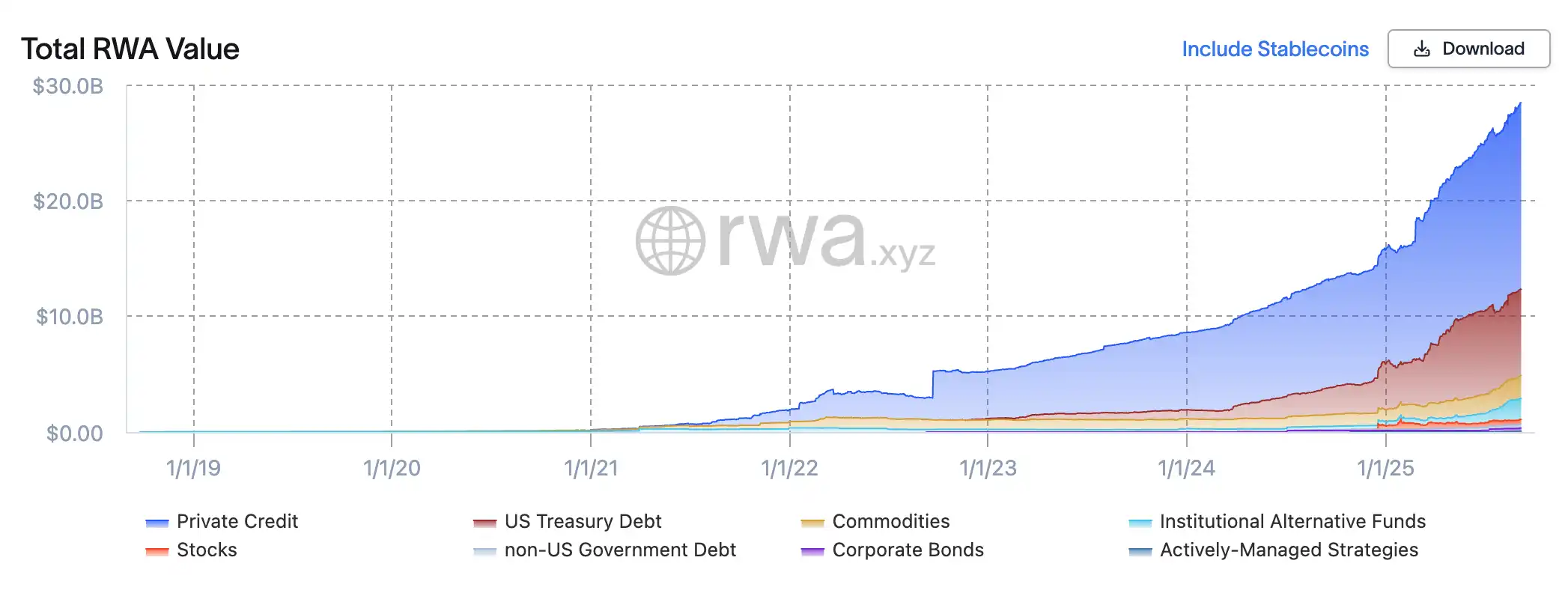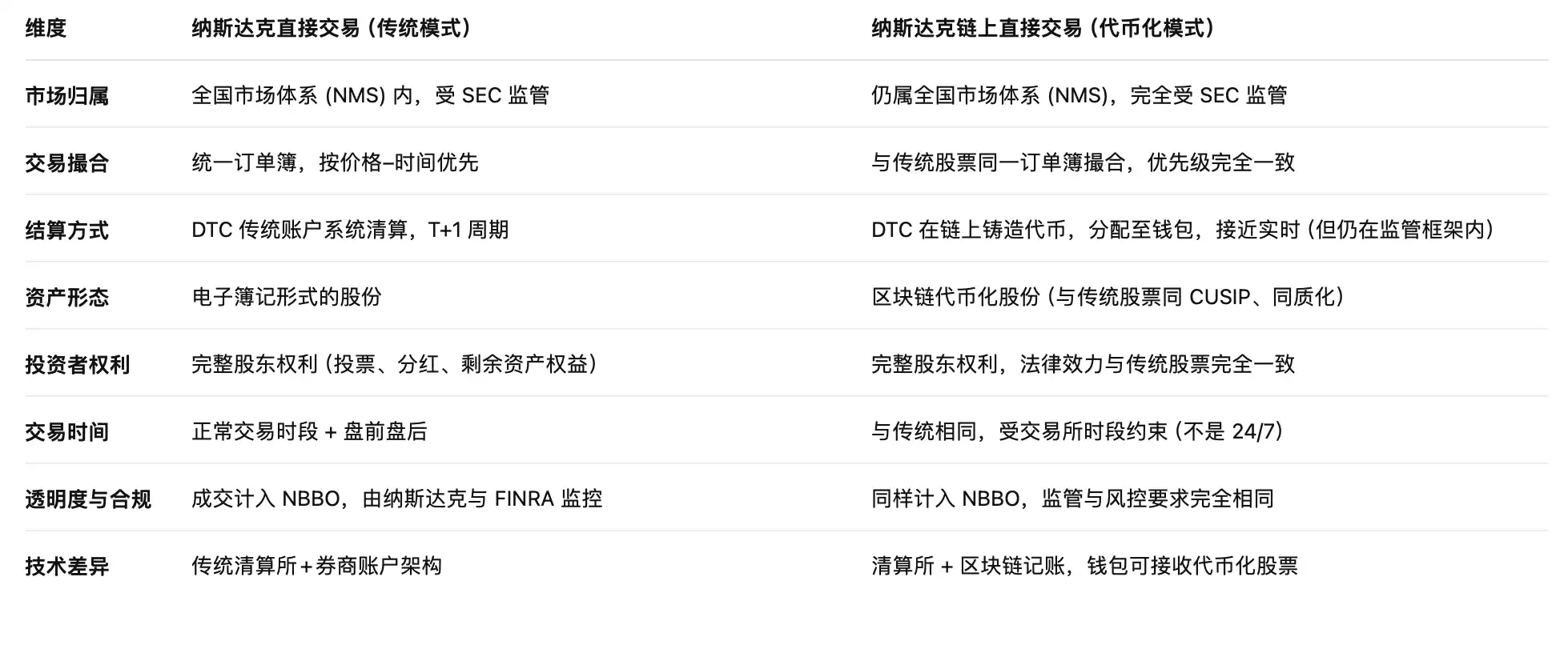In less than two years, the tokenized securities market has experienced nearly "explosive" growth. According to data from RWA.xyz, the total market capitalization of RWA (Real World Assets) tokenization has surpassed $2.8 billion, with on-chain stocks reaching $420 million—up from less than $5 million at the beginning of 2024, a staggering increase of over 80 times in just two years.

Driving this wave is the collective entry and accelerated layout of enterprises: Robinhood has launched tokenized private equity products covering popular targets like SpaceX and OpenAI; Kraken's XStocks has listed over 50 tokenized versions of U.S. stocks and ETFs; Ondo's Wall Street 2.0 has launched over 100 U.S. stocks and ETFs on Ethereum; Galaxy Digital has taken the lead in moving its Nasdaq-listed stock onto the public chain; and SBI Holdings has partnered with Startale to establish an on-chain trading platform in Japan. Whether from crypto-native companies or traditional financial giants, all are vying for the first-mover advantage in the emerging field of tokenized stocks.
This is not just a race between crypto and traditional finance; it is also seen as a potential "revolution" against the traditional exchange model. On September 8, Nasdaq, the world's second-largest exchange, chose to actively engage by submitting an application to the U.S. Securities and Exchange Commission (SEC) to officially embrace tokenized stocks, attempting to push this transformation from "marginal experimentation" to the core stage of Wall Street.
New Packaging Under the Old System: The Operating Logic of Tokenized Stocks
Tokenized stocks are not a new asset that has appeared out of nowhere, but rather a new "packaging form" of traditional equity. The key lies in how to integrate blockchain's accounting and settlement capabilities on top of the existing financial infrastructure. In the rule proposal submitted by Nasdaq to the SEC, this logic is articulated very clearly: in the future, when investors place orders, they can select the "tokenized settlement" option in the system, and trades will still be matched within the same order book, without gaining additional priority due to tokenization. The real change occurs after the trade—Nasdaq will pass the settlement instructions to the Depository Trust Company (DTC), which will transfer traditional stocks into a dedicated account and mint equivalent tokens on-chain, distributing them to brokers' wallets. This way, tokenized stocks maintain complete consistency with traditional stocks in the trading process, only introducing on-chain mapping at the settlement level.
This design means that tokenized stocks are not outside the National Market System (NMS), but are incorporated into the existing regulatory and transparency framework: transactions will still be counted towards the National Best Bid and Offer (NBBO), ownership and voting rights are completely consistent with traditional stocks, and trading surveillance is jointly executed by Nasdaq and FINRA. In other words, tokenization here is not "starting from scratch," but rather an upgrade of the underlying infrastructure. "We are not trying to replace the existing system, but to provide the market with another more efficient and transparent technological option," said Chuck Mack, Senior Vice President of Nasdaq North America Markets, in an exclusive interview. "Tokenized securities are just the same asset expressed in a new form on the blockchain." This allows for the utilization of existing market structures and clearing systems while enabling blockchain to become a new generation of custody and settlement tools.
From a more macro perspective, the appeal of tokenization lies in its ability to address several core pain points in the capital markets. First is settlement efficiency—under the current system, stock trades typically require T+1 or even longer to complete settlement, while on-chain settlement can achieve near real-time clearing, reducing counterparty risk. Second is trading time and accessibility—traditional exchanges follow a market opening and closing system, and cross-border investments require multiple intermediaries, while tokenized stocks can theoretically be traded 24/7 and are more easily accessible to overseas investors through blockchain wallets. Finally, there is the programmability of assets, which means that proxy voting, dividend distribution, and even corporate governance could potentially be automated and made transparent with the support of smart contracts.

In the long run, Nasdaq has positioned tokenization as the next iteration of capital market infrastructure. According to the plan, as the DTC upgrade is completed, on-chain settlement functions are expected to be implemented as early as the third quarter of 2026, at which point tokenized stocks will coexist with traditional stocks in the regulated U.S. market. Nasdaq has explicitly rejected advancing through exemptions or workarounds, which not only upholds the principle of investor protection but also avoids the risk of liquidity fragmentation.
Path Differences Among Different Players
xStocks: Compliant Custody + DeFi Composability
xStocks, driven by Backed Finance, builds an SPV to hold real stocks based on the DLT laws of Switzerland and Liechtenstein, and then mints tokens on the public chain at a 1:1 ratio. The tokens are legally prioritized debt certificates backed by assets, with custodians and real-time reserve proof behind them. The issuance and trading sides are separated, allowing tokens to circulate on centralized exchanges like Kraken and Bybit, as well as connect to DeFi protocols like Jupiter and Kamino on Solana. The highlight of this model is its openness and transparency, truly possessing cross-market and cross-protocol composability, but the downside is that liquidity remains limited, and the market size is still insufficient to compete with off-chain.
Robinhood: A Closed-Loop On-Chain Experiment by a Licensed Broker
Robinhood, on the other hand, has taken a completely different path. It relies on the MiFID II license of its Lithuanian subsidiary to procure and custody U.S. stocks, ETFs, and private equity within a compliant framework, and then mints corresponding tokens on the Arbitrum chain. All token transactions are completed in a closed loop within Robinhood's own app, with tokens and real stocks mapped in real-time, ensuring that "on-chain quantity = custody position." The advantage of this model is regulatory control and consistent user experience, even enabling fractional share dividends and on-chain clearing, but tokens are almost impossible to transfer freely, lacking open liquidity. Robinhood views tokenization as a tool for expanding its financial territory rather than merely a market innovation.
Galaxy: The "Native Token" of a Public Company Self-Moving On-Chain
In contrast to the first two, Galaxy Digital has chosen to directly move its Nasdaq-listed stock onto the chain. It collaborates with the registered transfer agent Superstate, allowing shareholders to convert GLXY common stock 1:1 into tokenized shares on Solana through a compliant process. Unlike "mirror tokens" or "synthetic contracts," these tokens are legally recognized as real shares, enjoying full voting and dividend rights. Galaxy's attempt has achieved "equal rights for tokens and stocks" for the first time, laying the foundation for a true on-chain equity market. However, its liquidity is still in the early stages, currently only supporting peer-to-peer trading among registered users, and it needs further regulatory relaxation to reach a fully-fledged secondary market.
Ondo: Building Wall Street 2.0
Ondo Finance, founded by former Goldman Sachs executives, follows a path of "institutional-grade packaging + open distribution." The newly launched Ondo Global Markets platform has tokenized over 100 U.S. stocks and ETFs on Ethereum, providing a legal on-chain investment entry for non-U.S. investors. Its model is: Ondo purchases and holds real stocks through licensed brokers, then mints tokens on-chain at a 1:1 ratio, ensuring that each token possesses complete economic rights, including dividends and corporate actions. Ondo's highlights are scalability and openness—it not only has daily reserve proof, bankruptcy isolation, and third-party custody but also supports cross-chain interoperability and DeFi composability, allowing users to invest in star stocks like Apple and Tesla while also using tokens as collateral for lending and automated strategies. Ondo has turned tokenization into a "global financial supermarket," attempting to combine Wall Street's liquidity with blockchain's transparency, creating a true Wall Street 2.0.

Related Reading: "How is Tokenization of U.S. Stocks Achieved from Robinhood to xStocks?"
Embrace or Risk? The On-Chain Test for Wall Street
Nasdaq's formal submission of a tokenized stock trading application to the SEC is seen as a "core attempt" by Wall Street in the digitalization process. The core of this proposal is that tokenized stocks should enjoy the same rights and protections as their underlying securities, with trade matching still occurring in the existing order book, and clearing being handled by the DTC, which will mint equivalent tokens on-chain. This means that tokenization is no longer a marginalized experiment but may become part of the institutional infrastructure of the U.S. capital markets. Compared to Robinhood or xStocks, which remain in the realm of price mapping and contract certificates, Nasdaq's path is more thorough—it becomes the first to fully migrate all shareholder rights (voting rights, dividend rights, governance rights) onto the chain. This means that investors are no longer receiving a "shadow" of the stock, but the digital stock itself with complete rights.
Nasdaq CEO Tal Cohen stated, "Blockchain technology offers unprecedented possibilities for shortening settlement cycles, modernizing proxy voting, and automating corporate actions." In other words, Nasdaq is not looking to overthrow the old order but hopes to upgrade the market's underlying architecture with minimal institutional friction, ensuring that the core principles of investor protection and market transparency remain intact. For regulators, this stance sends a positive signal—rather than allowing tokenization to grow wildly in overseas or gray areas, it is better to directly incorporate it into a regulated framework.
However, negative voices also exist. JPMorgan bluntly stated in a research report that the tokenization of bonds and stocks "has not gained significant adoption outside of crypto-native companies," warning the market not to overstate short-term prospects. Citadel Securities cautioned that if regulators rush to advance without clear rules, it could instead trigger market risks. Globally, the World Federation of Exchanges (WFE) has also written to regulators, expressing concerns that tokenized stocks may "mimic" real equity but could lack shareholder rights and protections, calling for strengthened legal applicability and custody frameworks. These doubts indicate that while the potential for tokenization is enormous, institutional implementation still requires a long adjustment period.
Conclusion
Nasdaq's proposal is not just a technical adjustment but a "trial" of institutional nature. If the SEC ultimately approves it, it will mark the first time blockchain technology occupies a core position in the U.S. mainstream stock market and may lay the groundwork for future 24/7 trading, instant settlement, and smart contract governance. However, before all this truly happens, the market still needs to observe: whether regulators can provide a clear framework, whether investors can trust this new model, and whether tokenization can indeed bring value beyond traditional markets.
免责声明:本文章仅代表作者个人观点,不代表本平台的立场和观点。本文章仅供信息分享,不构成对任何人的任何投资建议。用户与作者之间的任何争议,与本平台无关。如网页中刊载的文章或图片涉及侵权,请提供相关的权利证明和身份证明发送邮件到support@aicoin.com,本平台相关工作人员将会进行核查。




